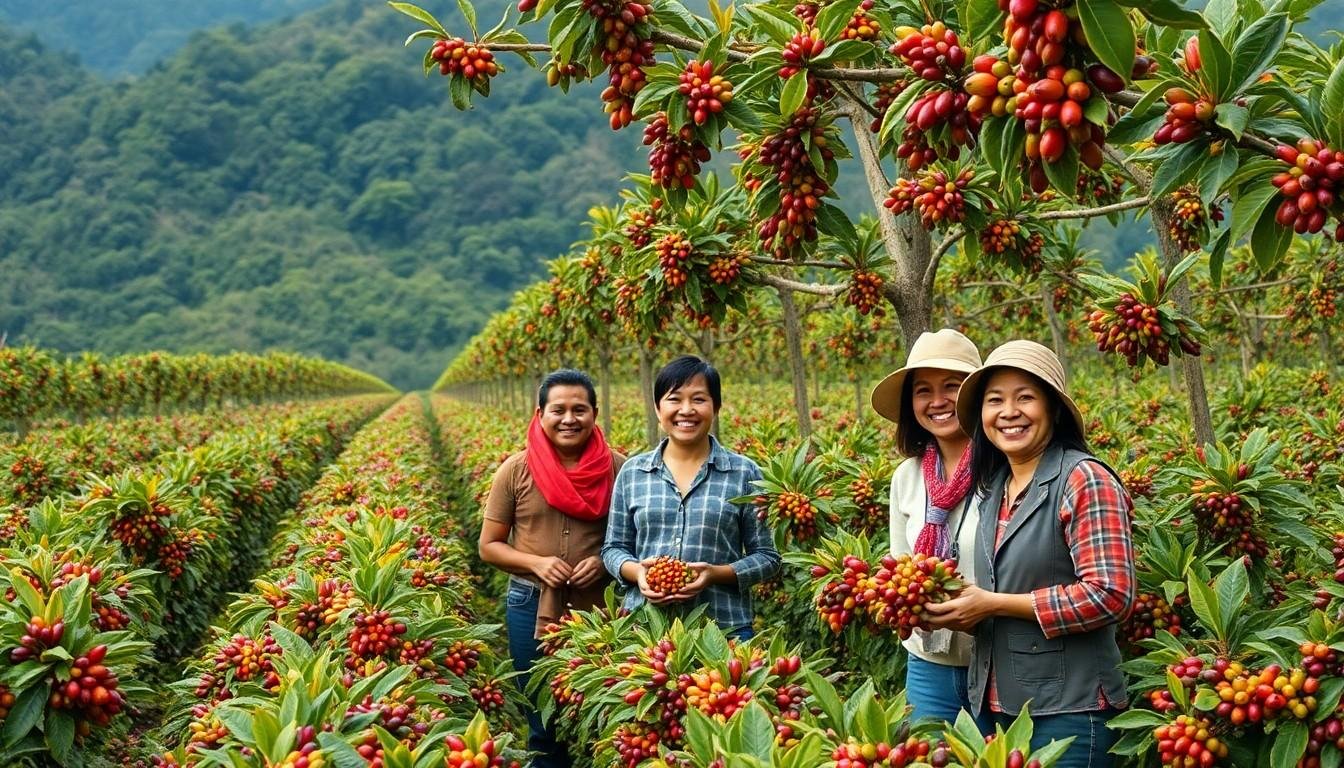
Artisanal Rituals for a Memorable Customer Experience
How can brands create a more balanced and memorable customer experience by blending artisanal product quality with thoughtful everyday rituals that keep people coming back?

Few beverages have shaped human society quite like coffee. The history of coffee and its cultural significance can be traced back to the ancient coffee forests of Ethiopia, where legend tells of a goat herder named Kaldi who discovered coffee’s energizing effects when his goats became unusually spirited after eating certain berries.
From these humble beginnings, coffee has evolved into a global phenomenon that transcends mere consumption. The history of coffee and its cultural significance is deeply woven into the fabric of societies worldwide, influencing art, literature, politics, and social customs. Coffee houses emerged as intellectual hubs during the Enlightenment, sparking revolutions and artistic movements across Europe and the Middle East. Today, the $100+ billion industry continues to shape economies and daily rituals for billions of people around the world. Modern roasters like Equipoise Coffee honor this rich heritage by maintaining perfect balance in their bean-to-cup process while delivering freshly roasted coffees that continue coffee’s time-honored tradition of bringing people together.
Coffee’s journey began in the ancient highlands of Ethiopia before spreading to Arabia where it was first cultivated commercially. This remarkable bean transformed from a local curiosity into a global commodity through centuries of trade, cultural exchange, and innovation.
The coffee plant (Coffea) originated in the Ethiopian highlands, specifically in the region of Kaffa. According to popular legend, a goat herder named Kaldi noticed his goats becoming unusually energetic after eating berries from a certain tree. Curious about the effect, Kaldi tried the berries himself and experienced a similar energizing sensation. He brought the berries to a local monastery where monks initially disapproved but later discovered that brewing the beans created a drink that kept them alert during evening prayers. This discovery, dating back to the 9th century, marked the beginning of coffee’s relationship with humanity. The plant itself, a flowering shrub with glossy green leaves and cherries containing two seeds (coffee beans), thrived in Ethiopia’s mountainous terrain with ideal growing conditions of high altitude, steady rainfall, and rich soil.
Coffee cultivation began in earnest in Yemen during the 15th century, establishing the port city of Mocha as the world’s first coffee trading hub. Arab merchants carefully controlled the coffee trade, prohibiting the export of fertile beans to maintain their monopoly. The drink spread throughout the Muslim world, becoming particularly popular in religious contexts where alcohol was forbidden. By the 16th century, coffee houses called “qahveh khaneh“ emerged in major cities like Constantinople, Cairo, and Baghdad, becoming vital centers for social interaction and information exchange. Trade routes expanded along the Red Sea, through Egypt, and into the Ottoman Empire, with caravans of merchants transporting the precious beans across desert routes. Today, specialty coffee producers honor these historical traditions while bringing exceptional beans from these ancient growing regions to modern coffee enthusiasts.
Coffee’s journey beyond its Islamic origins transformed global trade and social customs throughout the 16th and 17th centuries. European powers quickly recognized coffee’s economic potential and cultural significance, leading to dramatic expansion of cultivation and consumption worldwide.
European colonial powers established vast coffee plantations across their territories, forever altering global agriculture and trade. The Dutch first successfully transported coffee plants to their colonies in Java and Sumatra in the early 1700s, creating production centers that rivaled Yemen’s monopoly. French cultivation quickly followed in the Caribbean, particularly in Saint-Domingue (modern Haiti), which produced half the world’s coffee by the 1780s. Portuguese colonists introduced coffee to Brazil in 1727, establishing what would become the world’s largest coffee economy. These colonial plantations relied heavily on enslaved labor, creating brutal working conditions while generating enormous wealth for European powers. The cultivation patterns established during this period shaped modern coffee-growing regions across Latin America, Africa, and Asia, with many former colonies still dependent on coffee exports as economic mainstays.
Coffee houses emerged as revolutionary social institutions across 17th century Europe, transforming public discourse and intellectual life. The first European coffee house opened in Venice in 1645, with London’s first following in 1652. By 1700, London alone boasted over 2,000 coffee establishments, each serving as vibrant centers for news, politics, and business. Unlike taverns, coffee houses cultivated sobriety and intellectual engagement—earning nicknames like “penny universities” since patrons could access newspapers, debates, and lectures for the price of a coffee. These establishments became birthplaces of modern journalism, insurance companies, and stock exchanges. In Paris, cafés like Café Procope emerged as centers for Enlightenment thought, hosting revolutionaries and philosophers. The modern coffee experience at specialty shops like Equipoise Coffee continues this tradition, creating spaces where quality coffee facilitates conversation and community, much as these historic establishments did centuries ago.

Coffee transformed how people socialize, creating spaces for connection and conversation that transcended social barriers. The emergence of coffee houses in the 16th and 17th centuries established new cultural hubs where ideas flourished and communities formed around the shared experience of enjoying this stimulating beverage.
Coffee houses emerged as vital intellectual hubs where knowledge flowed as freely as the dark beverage itself. When examining the history of coffee and its cultural significance, these establishments stand out as transformative social spaces. In 17th century London, establishments like Lloyd’s Coffee House attracted merchants, writers, and politicians who exchanged ideas while sipping on freshly brewed cups. These venues became known as “penny universities” because for the price of a coffee, patrons accessed newspapers, engaged in debates, and participated in the intellectual discourse of the day. In Paris, the Café Procope hosted enlightenment thinkers like Voltaire and Diderot, while Vienna’s coffee houses nurtured artistic movements and revolutionary political ideologies. The combination of caffeine’s stimulating effects and the social setting created perfect conditions for extended discussions, literary creation, and scientific discourse that shaped Western thought – a testament to the history of coffee and its cultural significance throughout Europe.
Café culture transformed social interaction by creating democratic spaces where people gathered regardless of social status. In cities across Europe, cafés established distinct atmospheres with signature traditions—from Viennese coffee houses with their marble tables and newspapers on wooden holders to Italian espresso bars where patrons stood for quick, powerful shots. The ritualistic elements of coffee service—the elegant cups, specialized brewing methods, and accompanying pastries—became cultural touchstones that defined local identity. Today, specialty cafés continue this tradition by creating thoughtfully designed spaces where community connections thrive. The modern café serves as both a third place between home and work and a cultural institution where shared coffee experiences build relationships. From laptop-friendly workspaces to weekend gathering spots, cafés remain central to social fabric worldwide.

Coffee has profoundly shaped international relations and economic systems throughout history. This humble bean transcended its role as a beverage to become a political commodity and economic force that altered the course of nations and empires.
Coffee’s economic value drove colonial expansion as European powers established plantations throughout their empires. In the 17th and 18th centuries, coffee became a primary motivation for territorial conquest, with nations fighting for control of suitable growing regions. The Dutch East India Company monopolized production in Indonesia, while the French developed massive plantations in Haiti, and the British expanded cultivation throughout their colonies.
Coffee trading routes created wealth for colonial powers while extracting resources from producing regions. This “coffee capitalism” established economic systems that persist today, with most production occurring in formerly colonized regions of Africa, Latin America, and Asia. The triangular trade patterns involving coffee, sugar, and enslaved people underpinned the early global economy. Coffee plantations became crucial revenue generators for colonial powers, providing tax income and creating economic dependencies that lasted well beyond colonial rule.
Today’s coffee industry represents a $465 billion global market employing over 125 million people worldwide. Major producing countries like Brazil, Vietnam, and Colombia depend heavily on coffee exports, with fluctuations in coffee prices capable of destabilizing entire economies. The coffee supply chain connects farmers in developing nations with consumers in wealthy countries through complex networks of traders, processors, and retailers.
Fair trade movements emerged in response to historical inequities in the coffee industry. Organizations promoting equitable coffee trade work to ensure producers receive fair compensation for their labor and crops. Companies like Equipoise Coffee exemplify this ethical approach, focusing on balanced pricing models that benefit both farmers and consumers. These initiatives recognize coffee’s political dimensions by addressing wage disparities and working conditions in producing regions. By supporting transparent pricing and sustainable practices, modern coffee consumers participate in reshaping global economic relationships that were historically exploitative, demonstrating how coffee continues to influence both political consciousness and economic structures worldwide.
Coffee rituals transcend mere consumption, embodying cultural heritage and social connection across diverse societies. These ceremonies transform the simple act of brewing and drinking coffee into meaningful cultural expressions that reflect historical traditions, values, and community bonds.
The Ethiopian coffee ceremony represents one of the world’s most elaborate coffee rituals, serving as a vital cultural institution. This three-hour ceremony begins with the washing and roasting of green coffee beans over hot coals, followed by grinding the beans with a wooden mortar and pestle. The hostess brews the coffee in a traditional clay pot called a jebena, pouring the finished coffee into small cups from a height to create a thin layer of foam. Participants typically enjoy three rounds of coffee—abol (first), tona (second), and baraka (third)—accompanied by snacks like popcorn or roasted barley. The ceremony creates an intimate social space where community members gather to discuss important matters, share news, and strengthen relationships. Today, families perform this ritual daily, and it remains an essential expression of hospitality where refusing an invitation is considered impolite.
Coffee preparation varies dramatically across cultures, with each method reflecting local ingredients, equipment, and cultural preferences. In Turkey, coffee preparation involves finely ground beans simmered in a copper cezve with sugar and cardamom, creating a thick, unfiltered brew served with the grounds settled at the bottom. The Italian espresso tradition uses pressure to extract intense flavor from finely ground beans in seconds, forming the foundation of modern café culture. Meanwhile, Vietnamese coffee employs a phin filter to slowly drip strong coffee over sweetened condensed milk, creating a rich, sweet beverage that counterbalanced French colonial influence with local tastes. In Finland, kaffeost involves pouring hot coffee over cubes of juustoleipä cheese, creating a unique combination of flavors. For coffee enthusiasts seeking authentic global experiences, Equipoise Coffee offers specialty beans sourced from these diverse regions, allowing home brewers to recreate traditional preparation methods with carefully selected, ethically sourced beans.
Coffee consumption patterns have transformed dramatically over centuries, reflecting changing social structures, economic developments, and cultural preferences. This beverage has evolved from an exotic luxury to a global necessity, fundamentally altering how societies function and connect.
Coffee’s journey from exclusivity to ubiquity began in the 17th century when only the wealthy could afford this exotic import. European aristocracy initially consumed coffee as a status symbol, serving it in specially designed porcelain cups that displayed their refinement and wealth. By the 19th century, industrial advances in roasting, grinding, and packaging democratized access, transforming coffee into a working-class staple. The invention of vacuum packaging in 1900 allowed coffee to be mass-distributed, while innovations like instant coffee (1938) and home brewing machines in the 1970s made preparation effortless. Coffee consumption rates surged from less than 2 pounds per capita in 1900 to over 9 pounds today in the United States. This transition from luxury to necessity paralleled coffee’s integration into daily routines, with Americans now consuming 400 million cups daily – creating morning rituals that mark the transition from home to work life.
The Third Wave coffee movement emerged in the early 2000s as a reaction against mass-produced, commodity coffee. This movement approaches coffee as an artisanal food product rather than a standardized beverage, emphasizing direct trade relationships, sustainability, and appreciation for coffee’s complex flavor profiles. Third Wave roasters meticulously highlight farm origins, processing methods, and unique tasting notes, treating coffee with the same respect as fine wine. This movement has driven an explosion in specialty cafés that prioritize lighter roasts to showcase beans’ intrinsic qualities and barista expertise. Companies like Equipoise Coffee exemplify this approach, working directly with farmers to source exceptional single-origin beans that respect traditional growing methods while supporting ethical practices. Their specialty selection features coffee with transparent sourcing information, allowing consumers to trace their purchase from farm to cup. The Third Wave has fundamentally redefined consumer expectations, creating a market where coffee quality, origin story, and environmental impact have become as important as convenience and price.
Coffee’s rich sensory experience has inspired countless artists, writers, and creators throughout history. In paintings, literature, music, and film, coffee appears as both subject and symbol, reflecting its deep cultural significance across societies. Contemporary brands like Equipoise Coffee continue this tradition by sharing stories that celebrate coffee’s artistic and cultural heritage.

Artists have depicted coffee culture in their works since the beverage gained popularity in Europe. Dutch Golden Age painters featured coffee in still lifes and tavern scenes, highlighting its exotic appeal. In the 19th century, Impressionists captured Parisian café life, with artists like Henri de Toulouse-Lautrec documenting the social atmosphere of these establishments. Modern artists continue to explore coffee’s visual appeal, creating works from the medium itself—painting with coffee grounds and espresso to produce sepia-toned images that connect to coffee’s natural aesthetic.
Coffee fuels both writers and their literary worlds. The café setting appears prominently in works by Ernest Hemingway, Franz Kafka, and Jean-Paul Sartre, who frequently wrote in Parisian coffee houses. In T.S. Eliot’s “The Love Song of J. Alfred Prufrock,“ the repeated line “In the room the women come and go / Talking of Michelangelo“ evokes intellectual coffee house conversations. Contemporary fiction continues to use coffee as a narrative device, with coffee shops serving as meeting places for characters and the ritual of coffee preparation revealing aspects of personality and culture.
Coffee permeates popular culture as a visual shorthand for comfort, stimulation, and social connection. The Central Perk café in “Friends” functioned as the show’s communal hub, while films like “Coffee and Cigarettes“ use the shared coffee ritual to structure meaningful conversations. Musicians reference coffee in lyrics across genres, from jazz standards to contemporary pop, celebrating its role in daily life and creative productivity.
The coffee industry faces unprecedented challenges from climate change, with rising temperatures threatening traditional growing regions. Coffee plants thrive in specific conditions—consistent temperatures between 60-70°F and predictable rainfall patterns—that are increasingly disrupted by extreme weather events. Research shows that by 2050, up to 50% of current coffee-growing land may become unsuitable for production, particularly affecting arabica varieties that comprise 60% of global coffee production.
Sustainability initiatives are transforming the industry’s approach to these challenges. Companies lead the charge by implementing regenerative farming practices that improve soil health, increase carbon sequestration, and enhance ecosystem resilience. These methods include shade-grown cultivation techniques that protect coffee plants from temperature fluctuations while preserving biodiversity and providing additional income streams for farmers through crop diversification.
Technological innovations are revolutionizing coffee production from farm to cup. Precision agriculture tools like soil moisture sensors, drone monitoring, and AI-powered disease detection help farmers maximize yields while minimizing resource use. In processing and roasting, advanced equipment reduces energy consumption by 35%, while blockchain technology enables unprecedented transparency in the supply chain, allowing consumers to trace their coffee from specific farms through Equipoise Coffee’s verification system.
Consumer trends increasingly favor ethically sourced, environmentally responsible products, creating market demand for sustainable practices. This shift has prompted a 40% growth in direct trade relationships that eliminate middlemen and ensure farmers receive fair compensation for their crops, building more resilient coffee communities prepared to face future challenges.
Coffee’s journey from Ethiopian highlands to global phenomenon represents one of humanity’s most profound cultural exchanges. The history of coffee and its cultural significance spans centuries of trade routes, during which coffee has transformed societies, creating spaces for intellectual discourse, political revolution, and daily ritual.
The history of coffee and its cultural significance continues to evolve as the humble coffee bean connects us across continents, shaping economies and cultures while adapting to modern challenges. As climate change threatens traditional growing regions, the industry evolves through sustainable practices and ethical sourcing. Modern roasters like Equipoise Coffee exemplify this evolution, maintaining balance and harmony in their coffee-making process while honoring coffee’s rich cultural heritage.
What began with a curious goat herder named Kaldi has become an essential part of human experience. The history of coffee and its cultural significance lives on in every carefully brewed cup, reminding us how a simple beverage can bridge divides, foster community, and inspire innovation for generations to come.
Coffee originated in Ethiopia, where legend says a goat herder named Kaldi discovered its energizing effects when his goats became unusually active after eating berries from certain plants. The ideal growing conditions in Ethiopia’s highlands allowed the coffee plant to thrive naturally. By the 15th century, coffee cultivation began in Yemen, establishing the port city of Mocha as the first coffee trading hub.
Coffee spread globally through trade and colonization during the 16th and 17th centuries. European powers recognized coffee’s economic potential and established plantations in their colonies. The Dutch transported coffee plants to Java and Sumatra, the French cultivated it in the Caribbean, and the Portuguese introduced it to Brazil, which became the world’s largest producer. Unfortunately, these colonial plantations relied heavily on enslaved labor.
Coffee houses revolutionized social and intellectual life, particularly in 17th century Europe. First appearing in Venice in 1645, they spread to London and Paris as “penny universities” where people from different social classes could exchange ideas, discuss politics, and conduct business. They fostered sobriety and intellectual engagement, contributing to modern journalism and even financial institutions like Lloyd’s of London.
Coffee transformed into a $465 billion industry employing over 125 million people worldwide. During the 17th and 18th centuries, its economic value drove colonial expansion and created “coffee capitalism” systems that persist today. Most production occurs in formerly colonized regions, where price fluctuations can destabilize economies. In response, fair trade movements emerged to ensure fair compensation for producers and promote sustainable practices.
The Ethiopian coffee ceremony is perhaps the most elaborate, lasting up to three hours and serving as a vital community-building ritual. Other notable traditions include Turkish coffee prepared in a cezve, Italian espresso culture, and Vietnamese coffee made with a phin filter. These diverse practices reflect local ingredients, techniques, and social customs that have developed around coffee consumption across different cultures.
Coffee evolved from an exotic luxury in the 17th century to a daily essential. Initially a status symbol for the wealthy, it became accessible to working classes by the 19th century through improved production and distribution. The 20th century brought instant coffee and home brewing machines, further democratizing consumption. Today, Americans drink 400 million cups daily, and the Third Wave movement has transformed coffee into an artisanal product valued for quality and ethics.
Climate change poses unprecedented challenges to coffee production, threatening traditional growing regions with rising temperatures, irregular rainfall, and increased pest and disease pressure. In response, the industry is adopting sustainable practices like regenerative farming, shade-grown cultivation, and precision agriculture tools. These initiatives aim to protect both coffee’s future and the livelihoods of millions who depend on its production.
The Third Wave coffee movement emerged in the early 2000s, treating coffee as an artisanal product rather than a commodity. It emphasizes direct trade relationships, sustainability, and appreciation of coffee’s complex flavors. This movement led to a surge in specialty cafés focused on quality sourcing, careful preparation, and consumer education about origin and production methods. Companies like Equipoise Coffee exemplify this approach with transparency in sourcing and connection to origins.

How can brands create a more balanced and memorable customer experience by blending artisanal product quality with thoughtful everyday rituals that keep people coming back?

Independent coffee shops have always been about more than caffeine—they’re hubs of creativity, connection, and care. As café culture continues to evolve, new trends are

Introduction Independent cafes win when they feel like the neighborhood’s living room and operate with the discipline of a great kitchen. Below is a quick

Discover how top specialty coffee brands create lasting loyalty through storytelling, sourcing, and community connection. Real tips from 6 industry experts.

Discover the ultimate showdown between two beloved coffee brewing methods: the French press and Chemex. Explore how each technique caters to distinct palates, with the French press delivering bold flavors and the Chemex presenting a bright, clean taste.

Unlock the secrets to brewing the perfect cup of coffee with our comprehensive guide on using a coffee scale. Discover how precise measurements enhance flavor and consistency while eliminating bitterness.

Discover how water temperature plays a vital role in brewing the perfect cup of coffee. This article delves into the ideal temperature range of 195°F to 205°F for optimal flavor extraction, enhancing the enjoyment of high-quality beans.

Discover the world of curated specialty coffee bundles, perfect for enthusiasts seeking quality and craftsmanship. This article explores the benefits of ethically sourced, small-batch beans from brands like Equipoise Coffee, offering diverse flavor profiles that elevate your brewing experience.

Discover the art of manual brewing to elevate your coffee experience! This article explores various techniques like pour-over, French press, and AeroPress, revealing how they enhance flavor and your connection to every cup.